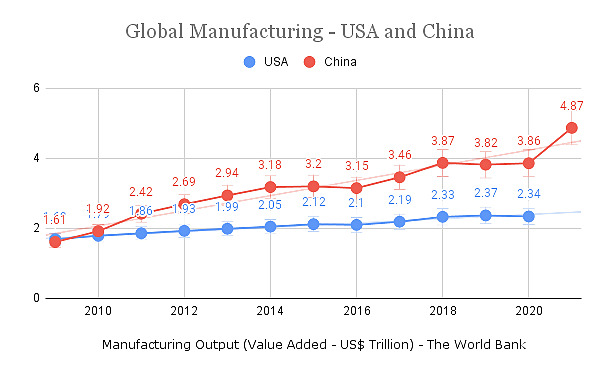
views
Despite being hit hard by the latest round of Covid surge, China retains the tag of being the largest manufacturing hub globally.
China became the world’s biggest manufacturer in 2010, replacing the United States, and increased the production gap over the years.
Data from the World Bank highlights the differences between the manufacturing outputs of USA, the biggest global manufacturer till 2009, and China, the biggest global manufacturer since 2010 in terms of USD.
The dataset shows how year after year, China’s manufacturing sector achieved a rapid growth.
The trend over the past two decades shows China rapidly catching up before actually overtaking the US.

The total value added by the manufacturing sector or the manufacturing output of the US in 2009 was almost similar to China, at USD 1.69 trillion.
ENDING THE DOMINANCE
The year 2010 marked the end of the US manufacturing dominance since 1895.
China was ahead of the US by USD 0.13 trillion dollar that year and went on to consistently increase the gap year after year. In 2021, China’s manufacturing output was USD 4.87 trillion, massively ahead of the US, creating a huge gap of USD 2.53 trillion.
The World Bank provides manufacturing output data for these two countries since 2004. China’s manufacturing output was not even half of what the US produced in 2004. The US, then the largest manufacturing economy globally, produced merchandise worth USD 1.61 trillion, while China’s output was USD 625.55 billion. But China crossed the USD 1-trillion mark in 2007.
THE COVID SITUATION
While coronavirus originated in China and soon spread across the world, the fact remains that it was one of the least affected countries before the latest surge this year. Between February 2020 and February 2022, China’s seven-day daily case average was below 1,000, the period during which the whole world was devastated with the pandemic, ruining economies and its related sectors.
Being the least affected country helped.
At USD 4.87 trillion, China saw a meteoric jump in its production activity in 2021. The year-on-year manufacturing output went up by USD 1 trillion, closing near the USD 5-trillion mark. The 2021 data for the US has not been released by The World Bank so far.
Covid affected China’s manufacturing output this year, but its long-term effects are yet to be seen.
AFTER THE SURGE
In February 2022, China saw a Covid surge, forcing the country to follow the ‘zero Covid’ policy. Many of China’s industrial hubs and commercial capitals namely Shanghai and Guangdong had to see lockdowns. However, last month, China saw manufacturing expansion since February.
The country’s Caixin manufacturing Purchasing Managers’ Index (PMI) came down to 48.1 in March from 50.4 in February 2022. The manufacturing PMI numbers indicate the health of China’s manufacturing health and industrial output.
According to ‘Trading Economics’, the Caixin exercise involves a survey of 430 private companies, and a rating of less than 50 means contraction of the manufacturing sector. 50 means no expansion and contraction and 50+ means expansion.
April and May saw next two months of contraction continuing.
As per the official data available from China’s National Bureau of Statistics (NBS), the PMI fell to 47.4 in April, from 49.5 in March 2022. The contraction was worse than what the Reuters’ survey expected, 48. The Caixin survey of private businesses for April showed the new export order index coming down to lowest since June 2020.
With Covid numbers coming down and lockdowns being eased, June saw manufacturing expansion at its highest in 13 months. The country’s Caixin manufacturing PMI rose to 51.7 from 48.1 in May, its highest since June 2021.
According to China Global Television Network (CGTN), the June PMI broke the market expectations by 3.6 points by ending at 50.1.
Read all the Latest News, Breaking News, watch Top Videos and Live TV here.


















Comments
0 comment